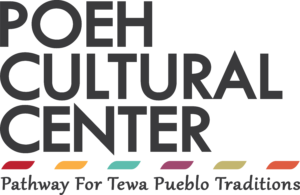The landmark Poeh Cultural Center & Museum is widely recognized for its traditional Pueblo architecture and building techniques. Until the facility’s completion, the Center’s programs, including its Museum, were offered in various venues throughout the eight northern Pueblos, which restricted access to program needs.
Phase I was a 7,560-square-foot facility that houses Poeh Arts’ classrooms, studios, and workshops. In late 1999, the construction of Phase II: an 18,966 square foot structure that houses the Center’s administrative offices and will host a 10,000 square foot Poeh Museum, which opened in fall 2002.
In keeping with the Poeh Center’s aim of intergenerational teaching of traditional Pueblo arts, the Pueblo of Pojoaque has incorporated training programs in the time-honored construction methods into the building of the Poeh Center through the State of New Mexico’s Youth Conservation Corps Program. This complements the Center’s training programs and internships in arts and museum administration and curatorial professions for young Pueblo Pojoaque Tribal members.
Facilities Overview
The focal point of the Poeh Cultural Center and Museum is the completed 4,930 square-foot museum building, which houses the Poeh Cultural Center and Museum administrative offices and the Poeh Museum’s Galleries and permanent exhibit Nah Poeh Meng. The Poeh administrative offices opened in 2000; the Collections Gallery, which houses the museum’s permanent collection, and the Rotating Exhibit Gallery opened to the public in 2003.
The Tower prominent features additional gallery space for renowned artist Roxanne Swentzell. Visit her site at www.roxanneswentzell.net
Plans for the Poeh Cultural Center and Museum include:
- A Children’s Museum featuring hands-on activities and interpretive exhibitions relating to Tewa children.
- An amphitheater hosting lectures and Native dances open to the public.
- Library and archive building.
Pojoaque’s Public Library will be moved to the facility, and Pueblo’s paper and photo archives will be available online and physically for tribal members and the public’s research.
The final phase of the Poeh Cultural Center will be the creation of a traditional Pueblo plaza similar to those found in the Pueblos throughout northern New Mexico. The plaza will feature traditional/contemporary Pueblo dances, bread making, and a permaculture garden that contains foods grown throughout the Pueblos, which provide a staple for the communities then and now.
Construction Process
Acknowledging the significance of the revitalization of Pojoaque Pueblo, the Pueblo of Pojoaque, the Poeh Cultural Center and Museum has been constructed, where possible, with traditional Pueblo architectural elements and building methods. To help preserve and revitalize these techniques — and to honor the communal approach to construction — many Pueblo community members have been a part of the Poeh Center and Museum’s construction, providing them with a unique opportunity to learn traditional Pueblo construction methods.
Pueblo peoples in northern New Mexico have been constructing their adobe homes for over 1,000 years. Historically, Pueblo Indians built large multistory adobe structures. These buildings, incorporating multifamily homes and communal spaces, were called “Pueblos” (translated as “Villages” in English) by early Spanish settlers.
Adobe is all-natural and consists of mud, water, hay, straw, and sometimes manure. Traditional adobe homes have a flat roof constructed of vigas (large wooden beams); more modern homes also include beehive-style fireplaces and Nichos (niches) carved out of the wall for religious displays.
When completed, the Poeh Center complex will resemble a traditional village, with multiple buildings surrounding open plazas.


